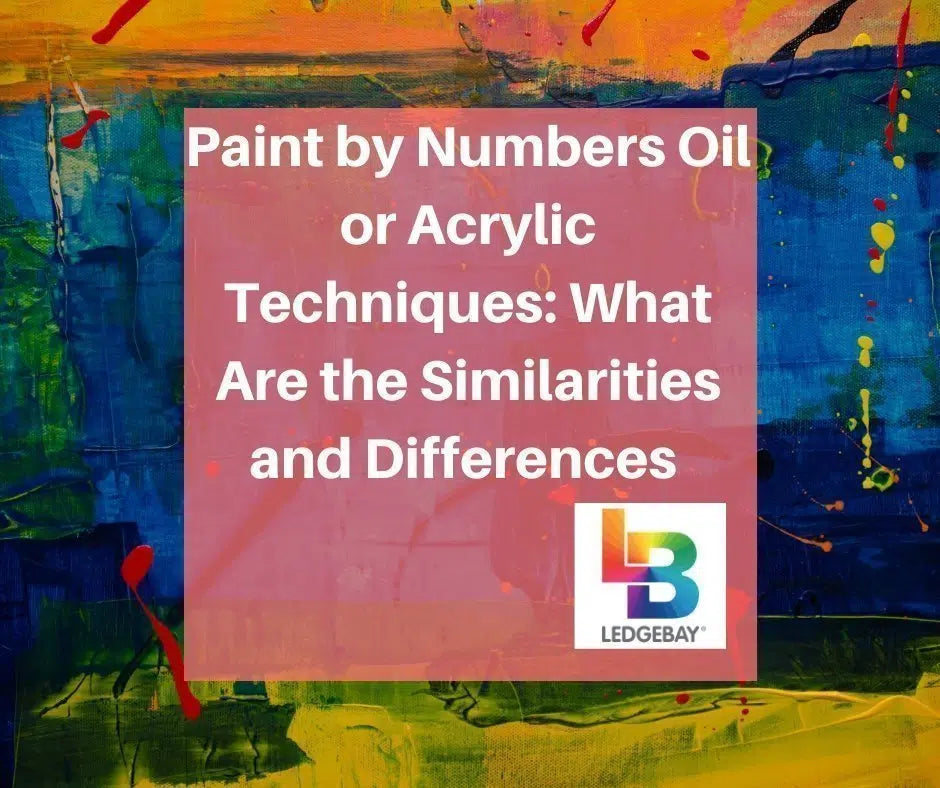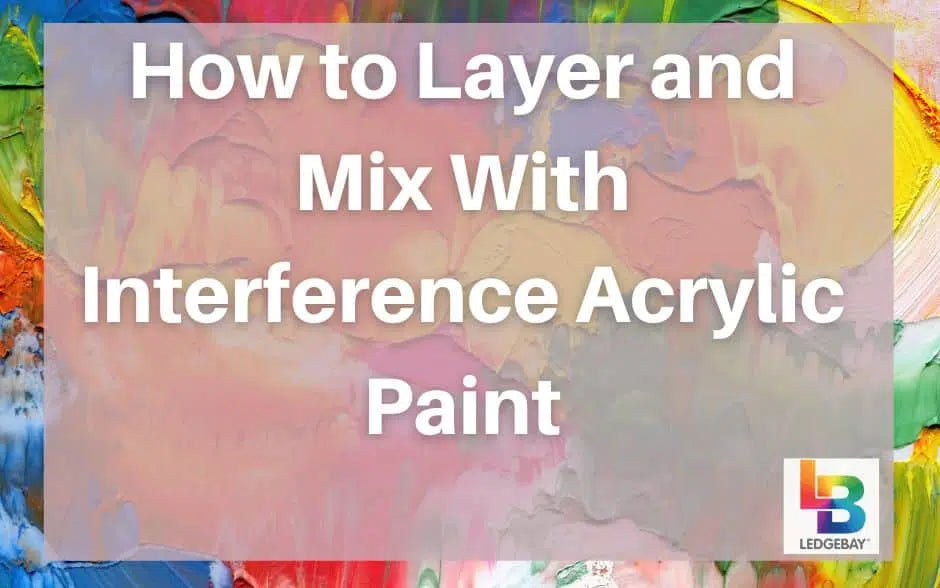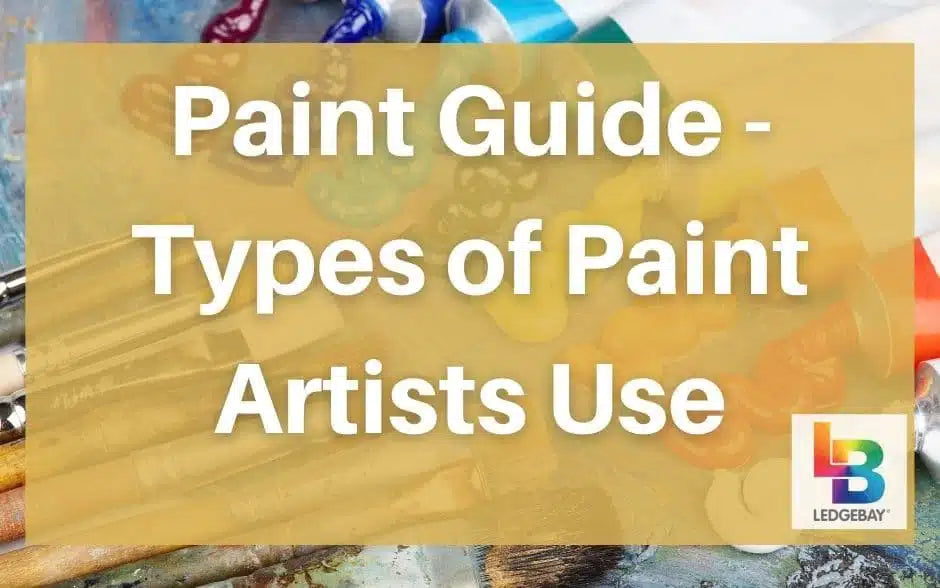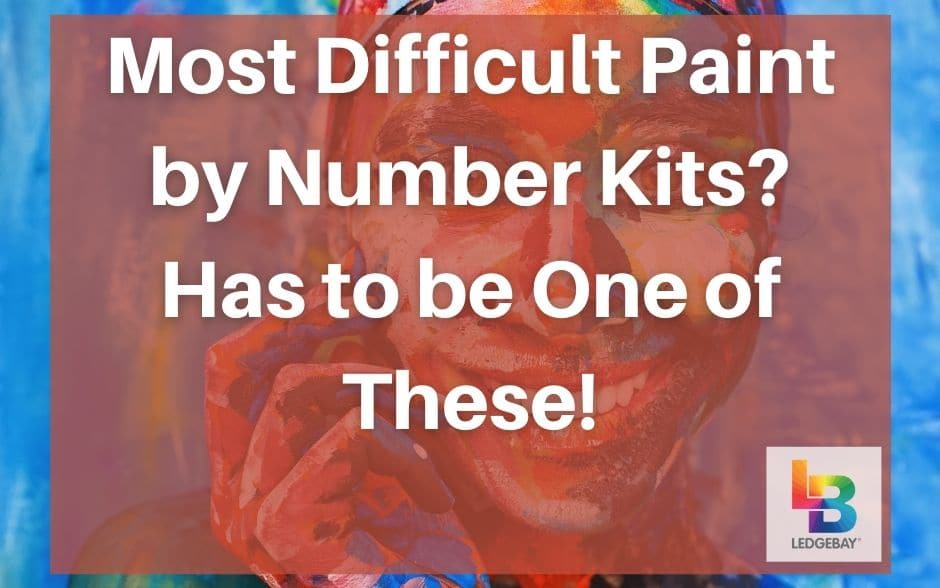Should you use paint by numbers oil oracrylic paints ? That’s arguably the biggest decision you will have to make, especially if you’re just learninghow to paint by numbers .
Although they look similar,acrylic and oil have fundamental differences , starting with how they are constructed.Oil paints are made by suspending pigments in oil (typically linseed oil).
That’s very important because in addition to giving them the title “oil paints”, it also makes them incompatible with water. To clean or thin your paint, you’ll need to use a different liquid like white spirit or turpentine.
Neither of those is usually included in apaint by numbers kit . And that means you’ll have to budget for it separately. Checkthis out if you want to know what’s included in a Ledgebay kit.
Nonetheless, oil is a classic in theworld of art . So don’t be surprised when a kit that has oilpaint sets you back a bit more than an acrylic one.
Speaking of acrylic, you’d be right to call it oil’s younger sibling. While the latter has been around since at least the 12th century,acrylic painting became a thing in the 1945s.
Acrylics are made by suspending pigment in an acrylic polymer emulsion. Unlike oil paints,acrylics can be thinned with water. They are quite affordable too.
But does that make the case foracrylics in our paint by numbers oil or acrylic review? Probably not. You’ll need more for a proper comparison; so here’s more.

When of the biggest differences between these two paints is the time they take to dry. And it may influence your decision when choosingpaint by numbers oil or acrylic kits.
Acrylic paints are water-based and so they dry very fast. They only take minutes, or hours tops, to dry. You can shorten that time some more by blowing warm air on thepaint by numbers canvas (using a hair dryer).
The short drying time means that you can quicklyadd a layer of paint on an already existing one. For example, if youpainted a wrong color , simply give it a few minutes to dry and then add a layer of the right color over the wrong one.
The only problem with that correction technique is that if the underlying color is darker than the overlaying one, then it might still be visible. That’s becauseacrylic paints don’t blend as smoothly as oils.
Speaking ofoil paints , they take longer than acrylics to dry. The exact time varies from a few days to months. For that reason,painting by numbers using oil is ideal for you if you like to work slowly.
And you just might enjoy blendingcolors whenever you paint a wrong color in a spot. The wayoil paints blend smoothly, mixing them might actually surprise you. But of course you shouldn’t do that intentionally, otherwise you risk spoiling the intended piece of art.
There’s a lot more to know aboutblending colors in painting . If you’re feeling curious, the good people at Will Kemp Art School haveadditional info that might help.
Virtually allpaint by numbers oil or acrylic kits come with brushes in the package. Most of the time you won’t have to find your own, unless the ones in thenumber kit are damaged.
Anyway, for the sake of “what if”, let’s say you have to buy your own brushes. Which type of bristles should you buy for oilpaint and which ones should you get for acrylic ?
First off, there are two types of bristles: synthetic and natural. The latter are made from animal fur, contrary to synthetic ones which are made of polyester and nylon.
While natural bristles are excellent for oil paint, synthetics are ideal for acrylic. That’s because synthetic bristles don’t absorb water. Remember I mentioned thatacrylic paint is water-based? Great, you don’t want yourbrush to keep absorbing that water because then you’ll have to keep thinning the paint .
Natural bristles, on the other hand, are a perfect match with oil paint. They are soft, and that’s good when you’re carryingoil paint . It will help you to paint within the lines.
If it does come to the point where you need toshop for brushes , you can get exciting deals at LedgeBay. Checkthis page out to see which brush works for your paint by numbers oil or acrylic design.
Lightfastness refers to how fast a color fades when exposed to light. Why is it important inpaint by numbers oil or acrylic techniques ? Because your finalpainting will be exposed to light most of the time, particularly if you’re planning to hang it.
Now,acrylic paint has an excellent lightfastness. Finishpainting by numbers using acrylic , frame your art, hang it and forget about it.
Well, maybe not completely. You have to dust it once on a while. Many years to come, that piece of art will still look the same.
Unfortunately, the same can’t be said for oil. Oils respond completely differently to lightfastness. They start to fade over time and appear yellowish after many years have passed.
That’s down to how oil is constructed. Its pigment becomes dull over time, allowing the oil binder to show through. If extreme durability is a concern when choosing apaint by numbers oil or acrylic kit , you may want to go for the latter.
Acrylic paints do not have that problem. You can bury yourself in apainting by numbers project for hours and you won’t get so much as a headache. With oil you’ll probably need a large, well-ventilated room if you want to work for hours on end.
In other words, examine your working space before choosing apaint by numbers oil or acrylic kit .
If you embark on two simultaneous projects, one oil and the other acrylic, the acrylicpainting will dry faster. And it will look amazing on any wall. The oil painting will take longer to dry but once it does, you’ll want it on the wall even more.
So, it’s (arguably) a win-win for oil and acrylic in terms of their ability toproduce quality art . But what else do they have in common?
Both types of paintshave their sets of ideal mediums . In case you’re wondering, a medium is something that changes the property of apaint .
For example, if you addlinseed to oil paint , it takes longer to dry. That’s a good strategy if you like taking your time whenpainting by numbers . You can correct edges,lines and corners before the paint dries.
If you want to work faster, you can speed up oil’s drying time by adding alkyd gel. And if you just want a glossy painting, consider adding poppy oil to your paint. The final art will look allshiny and glossy like the masterpiece that it should be.
Acrylic has its mediums too, but you may want to know that they are not essential to good art. If you’re a beginner, you definitely don’t need them. They’re more like add-ons.
Feel free to mix thecolors if you have some leftover paint after completing a project. Only mix acrylic with acrylic and oil with oil. You can then use themixed colors for any other art and craft projects that may pick your interest.
Mixing colors can produce a neutral color, which you can use as a base color for other projects. That’s just asidea in case you’re exploring the idea of doing more than paint by numbers.
As you ponder on that, there’s a general belief thatacrylic paints are good for beginners. Oils, on the other hand, are usually fronted as ideal for people who have experience inpaint by numbers .
Personally I don’t think that’s the case. It’s more about what you prefer between oil and acrylic. I could say budget is a factor but the cost difference between an oilkit and acrylic kit is too small and mostly negligible.
Still, below is a general recommendation if you need one. It may come in handy if you have never triedpaint by numbers and have no idea what to expect from both of these paints:
In case you’re looking for a flexiblepaint that dries quickly and doesn’t have an odor then acrylic is your best pick. But if you want a more traditional paint that takes longer to dry and is therefore pliable, consider going with an oil paint by numbers kit .
Don’t be shy tosubmit your finished painting to Ledgebay. You’ll get a lot of support and inspiration from other DIY painters, which may just be what you need to fullyunleash the artist in you.
Although they look similar,acrylic and oil have fundamental differences , starting with how they are constructed.Oil paints are made by suspending pigments in oil (typically linseed oil).
That’s very important because in addition to giving them the title “oil paints”, it also makes them incompatible with water. To clean or thin your paint, you’ll need to use a different liquid like white spirit or turpentine.
Neither of those is usually included in apaint by numbers kit . And that means you’ll have to budget for it separately. Checkthis out if you want to know what’s included in a Ledgebay kit.
Nonetheless, oil is a classic in theworld of art . So don’t be surprised when a kit that has oilpaint sets you back a bit more than an acrylic one.
Speaking of acrylic, you’d be right to call it oil’s younger sibling. While the latter has been around since at least the 12th century,acrylic painting became a thing in the 1945s.
Acrylics are made by suspending pigment in an acrylic polymer emulsion. Unlike oil paints,acrylics can be thinned with water. They are quite affordable too.
But does that make the case foracrylics in our paint by numbers oil or acrylic review? Probably not. You’ll need more for a proper comparison; so here’s more.

The Key Differences Between Acrylic and Oil
This is the part that you want to read carefully becausedifferent oils can have varying results . So, let’s get to it, shall we?Drying Time
[amazon box="B003FBG88E"]When of the biggest differences between these two paints is the time they take to dry. And it may influence your decision when choosingpaint by numbers oil or acrylic kits.
Acrylic paints are water-based and so they dry very fast. They only take minutes, or hours tops, to dry. You can shorten that time some more by blowing warm air on thepaint by numbers canvas (using a hair dryer).
The short drying time means that you can quicklyadd a layer of paint on an already existing one. For example, if youpainted a wrong color , simply give it a few minutes to dry and then add a layer of the right color over the wrong one.
The only problem with that correction technique is that if the underlying color is darker than the overlaying one, then it might still be visible. That’s becauseacrylic paints don’t blend as smoothly as oils.
Speaking ofoil paints , they take longer than acrylics to dry. The exact time varies from a few days to months. For that reason,painting by numbers using oil is ideal for you if you like to work slowly.
And you just might enjoy blendingcolors whenever you paint a wrong color in a spot. The wayoil paints blend smoothly, mixing them might actually surprise you. But of course you shouldn’t do that intentionally, otherwise you risk spoiling the intended piece of art.
There’s a lot more to know aboutblending colors in painting . If you’re feeling curious, the good people at Will Kemp Art School haveadditional info that might help.
Type of Bristle
[amazon box="B07ZMJKMWQ"]Virtually allpaint by numbers oil or acrylic kits come with brushes in the package. Most of the time you won’t have to find your own, unless the ones in thenumber kit are damaged.
Anyway, for the sake of “what if”, let’s say you have to buy your own brushes. Which type of bristles should you buy for oilpaint and which ones should you get for acrylic ?
First off, there are two types of bristles: synthetic and natural. The latter are made from animal fur, contrary to synthetic ones which are made of polyester and nylon.
While natural bristles are excellent for oil paint, synthetics are ideal for acrylic. That’s because synthetic bristles don’t absorb water. Remember I mentioned thatacrylic paint is water-based? Great, you don’t want yourbrush to keep absorbing that water because then you’ll have to keep thinning the paint .
Natural bristles, on the other hand, are a perfect match with oil paint. They are soft, and that’s good when you’re carryingoil paint . It will help you to paint within the lines.
If it does come to the point where you need toshop for brushes , you can get exciting deals at LedgeBay. Checkthis page out to see which brush works for your paint by numbers oil or acrylic design.
Lightfastness
[amazon box="B07Z8B74TR"]Lightfastness refers to how fast a color fades when exposed to light. Why is it important inpaint by numbers oil or acrylic techniques ? Because your finalpainting will be exposed to light most of the time, particularly if you’re planning to hang it.
Now,acrylic paint has an excellent lightfastness. Finishpainting by numbers using acrylic , frame your art, hang it and forget about it.
Well, maybe not completely. You have to dust it once on a while. Many years to come, that piece of art will still look the same.
Unfortunately, the same can’t be said for oil. Oils respond completely differently to lightfastness. They start to fade over time and appear yellowish after many years have passed.
That’s down to how oil is constructed. Its pigment becomes dull over time, allowing the oil binder to show through. If extreme durability is a concern when choosing apaint by numbers oil or acrylic kit , you may want to go for the latter.
Size of Your Working Space
Good as they are to the eye, oilpaints are not exactly friends of the nose. Their thinners, specifically white spirit and turpentine, have a strong and irritating smell. Those fumes can be overwhelming when you’re working in a small space.Acrylic paints do not have that problem. You can bury yourself in apainting by numbers project for hours and you won’t get so much as a headache. With oil you’ll probably need a large, well-ventilated room if you want to work for hours on end.
In other words, examine your working space before choosing apaint by numbers oil or acrylic kit .
Acrylic vs. Oil: The Key Similarities
It’s not all differences when it comes topaint by numbers oil or acrylic . They do have a few things in common. For starters, both options result in great art as long as you follow the design.If you embark on two simultaneous projects, one oil and the other acrylic, the acrylicpainting will dry faster. And it will look amazing on any wall. The oil painting will take longer to dry but once it does, you’ll want it on the wall even more.
So, it’s (arguably) a win-win for oil and acrylic in terms of their ability toproduce quality art . But what else do they have in common?
Mediums
[amazon box="B0149KTEPS"]Both types of paintshave their sets of ideal mediums . In case you’re wondering, a medium is something that changes the property of apaint .
For example, if you addlinseed to oil paint , it takes longer to dry. That’s a good strategy if you like taking your time whenpainting by numbers . You can correct edges,lines and corners before the paint dries.
If you want to work faster, you can speed up oil’s drying time by adding alkyd gel. And if you just want a glossy painting, consider adding poppy oil to your paint. The final art will look allshiny and glossy like the masterpiece that it should be.
Acrylic has its mediums too, but you may want to know that they are not essential to good art. If you’re a beginner, you definitely don’t need them. They’re more like add-ons.
Storage
The bestpaint by numbers kits usually have sealed containers (airtight) to preserve the paint. But just in case you want an extra method of storage, bothacrylic and oil paints last longer when stored in the fridge.Feel free to mix thecolors if you have some leftover paint after completing a project. Only mix acrylic with acrylic and oil with oil. You can then use themixed colors for any other art and craft projects that may pick your interest.
Mixing colors can produce a neutral color, which you can use as a base color for other projects. That’s just asidea in case you’re exploring the idea of doing more than paint by numbers.
Acrylic vs. Oil Paint: Which One Should You Choose?
It’s usually apaint by numbers oil OR acrylic kit; not oil and acrylic . So, you kinda have to choose one. From the comparison and contrast above, which one do you feel suits you best?As you ponder on that, there’s a general belief thatacrylic paints are good for beginners. Oils, on the other hand, are usually fronted as ideal for people who have experience inpaint by numbers .
Personally I don’t think that’s the case. It’s more about what you prefer between oil and acrylic. I could say budget is a factor but the cost difference between an oilkit and acrylic kit is too small and mostly negligible.
Still, below is a general recommendation if you need one. It may come in handy if you have never triedpaint by numbers and have no idea what to expect from both of these paints:
When to Choose Acrylic Paint by Numbers
[amazon box="B07R3TTPP3"]- Acrylic is great if your paint by numbers design has very small shapes. I’m talking about the type of small shapes that you can’t paint without going outside the borders.
- Every time your brush crosses the line, simply wait for the paint to dry and then apply the right paint in the affected spot. So, be sure to look at the design first and examine how detailed it is. If it has very small shapes to paint, go with acrylic.
- Similarly, if you’re buying a painting by numbers kit for your little one, consider acrylic over oil. Kids generally struggle to paint within borders. They frequently need to reapply paint in some spots whenever they make a mistake.
- Finally, choose acrylic if you’re a sucker for easy cleaning. Oil paints are harder to clean and you need white spirit or turpentine to really polish a surface in case of a spill. Water does the trick for acrylic paints.
When to Choose Oil Paint by Numbers
[amazon box="B07VHN2VCR"]- Oil is a great option if you like taking your time to complete a paint by numbers project. The fact that it takes longer to dry can be a good thing. It gives you time to evaluate your painting as you move slowly. Therefore, oil is an ideal choice for those who are deliberately cautious.
- Don’t forget that oil paints have a strong smell. It becomes even stronger when combined with a thinner. But you won’t feel the effects so much if you are working from a large and well-ventilated room. That’s to say, if your working space is small, go with acrylic. Otherwise, oil is as good an option as acrylic.
- Finally, oil brings that traditional painting style and feeling, which can be good for your motivation. It wouldn’t hurt to feel like Leonardo or Picasso just for a day or two.
Comparing the Pros and Cons of Acrylic and Oil Paint by Numbers
Pros
| Oil | Acrylic |
| · Takes time to dry, which makes the paint pliable for long | · Dries quickly. You can finish your project faster with acrylic |
| · No color shift; i.e. color doesn’t change when the painting dries | · Easy to achieve crisp edge. Great pick for detailed designs |
| · Easier to manipulate with medium | · Lightfast. Doesn’t fade in time |
| · Has a traditional, classy touch to it | · Doesn’t fade with time |
| · Leads to great paint by numbers art | · Easier |
Cons
| Oil | Acrylic |
| · Takes longer to dry Solution: gently blow warm air evenly on painting | · Dries too quickly Solution: add a retarder or palette to keep the paint wet for longer |
| · Yellowing Solution: none. Oil paintings just fade quicker | · Might change color when it dries Solution: use high-quality paint by numbers kits |
| · Strong odor Solution: use oil paint in a large, well-ventilated room | · Painting wet over dry acrylic can cause color bleed Solution: none, not much you can do here |
Final Thoughts
So,paint by numbers oil or acrylic? If you’ve made it this far then you probably have your answer. Both are great options, just a few differences here and there.In case you’re looking for a flexiblepaint that dries quickly and doesn’t have an odor then acrylic is your best pick. But if you want a more traditional paint that takes longer to dry and is therefore pliable, consider going with an oil paint by numbers kit .
Don’t be shy tosubmit your finished painting to Ledgebay. You’ll get a lot of support and inspiration from other DIY painters, which may just be what you need to fullyunleash the artist in you.











